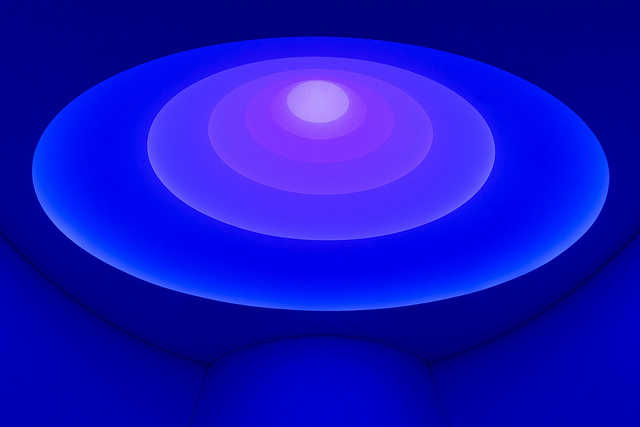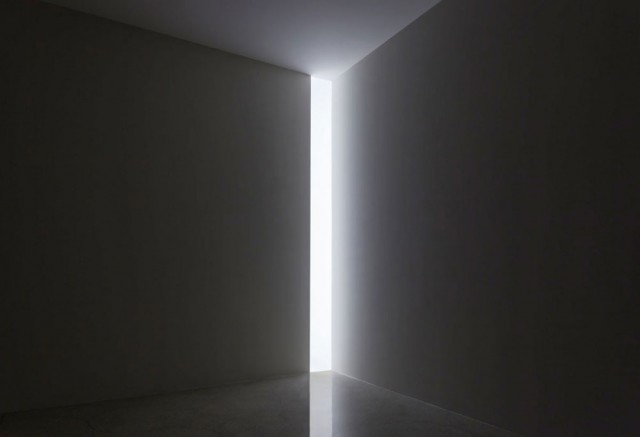
James Turrell’s “Aten Reign” bathes the Guggenheim in meditative colored light display (photo by David Heald / © Solomon R. Guggenheim Foundation, New York)
Solomon R. Guggenheim Museum
1071 Fifth Ave. at 89th St.
Friday – Wednesday through September 25, $18-$22 (pay-what-you-wish Saturday 5:45-7:45)
212-423-3587
www.guggenheim.org
During the last few years, the Guggenheim has staged several exhibitions in which the bays that line the winding interior have remained empty. In 2010, Tino Sehgal had trained men and women speak with visitors making their way to the top, with no physical art present at all. In 2011, Maurizio Cattelan’s career retrospective, “All,” consisted of an amalgamation of his works hung from the ceiling like a massive mobile, with nothing in the bays. Now James Turrell has created the site-specific “Aten Reign,” a dazzling, meditative spectacle in which five rings of light that echo the museum’s shape, beginning at the oculus at the top of the rotunda, slowly change colors in mystifying and intoxicating ways. Visitors have access only to the main floor and the first section of the spiraling ramp, with special arched benches at the bottom for more comfortable viewing, but make sure to walk around, as the display, which explores light, space, and perception, seemingly shifts form ever so slightly when seen from different positions and angles, affected by the natural daylight as well. Constructed with interlocking cones and LED fixtures, “Aten Reign” is like one of Turrell’s Skyscapes (such as his open-air “Meeting” at MoMA PS1) mixed with more subdued elements of the psychedelic Joshua Light Show while incorporating the Gazfeld effect. “I really felt to be using light as a material [is] to work or affect the medium of perception,” the L.A.-born Turrell explains in a promotional video. “For me, it’s trying to orient toward what the perception really is, rather than the object of perception, to actually, sort of, remove that. I have an art that has no image. It has no object. And even very little a place of focus, or one place to look. So, without image, without object, without specific focus, what do you have left? Well, a lot of it is this idea of seeing yourself see, understanding how we perceive.” The overall individual, hallucinatory experience grows the more you immerse yourself in its splendor, allowing it to take you to other places in your mind, body, and spirit. Take your time and let it envelop you, not worrying about anything else anywhere in the world.

James Turrell, “Afrum I (White),” projected light, 1967 (photo by David Heald / © Solomon R. Guggenheim Foundation, New York)
The show is supplemented with several rooms of other works, including a series of white-light pieces from the late 1960s that play with physical space and altered reality; “Prado (White)” appears to be a rectangular hole in the wall, “Afrum I (White)” looks like a floating cube, and the vertical “Ronin” has a special trick to it. Expect a ridiculously long line to see 1976’s “Iltar,” a mysterious wall piece that you’re not allowed to get too close to; don’t ask the guard what it actually is, because he’s not allowed to tell you. The Guggenheim is also screening a pair of short exhibition-related films, David Howe’s James Turrell, Second Meeting Art21 Exclusive and Peter Vogt and Erin Wright’s James Turrell’s Roden Crater, which examine other works by the artist; on September 20 they will be joined by Carine Asscher’s Passageways: James Turrell. Also on September 20, the afternoon symposium “James Turrell: Sensing Space” will feature presentations by Thomas Crow, Miwon Kwon, and Mark Taylor and a panel discussion moderated by exhibition co-curator Nat Trotman. Expect extended wait times for the last week of the much-talked-about show, which closes September 25, but it’s well worth it.